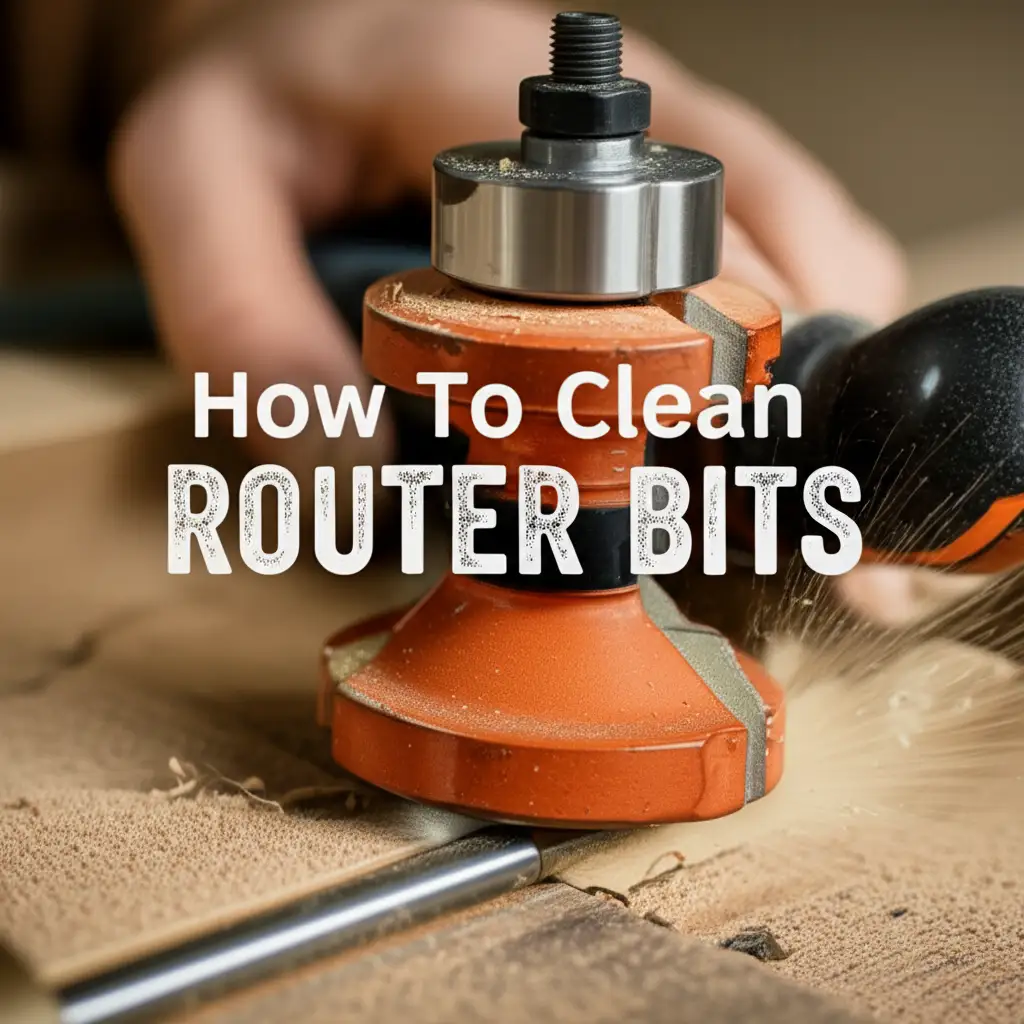· Tool Maintenance · 13 min read
How To Clean Router Bits

Keep Your Router Bits Sharp: A Guide to Effective Cleaning
Do your woodworking projects feel less precise? Is your router struggling more than usual? The answer might not be a dull bit, but a dirty one. Learning how to clean router bits is a simple yet crucial step for any woodworker.
Router bits collect pitch and resin from wood, building up over time. This sticky residue dulls the cutting edge and causes friction. Cleaning your router bits regularly restores their sharpness and helps them last longer. I will guide you through the process, providing clear steps and valuable tips. This article covers why cleaning is important, what tools you need, and how to maintain your bits for top performance.
Takeaway
Keeping router bits clean is vital for:
- Achieving precise, smooth cuts.
- Extending the lifespan of your expensive bits.
- Preventing overheating and motor strain on your router.
- Ensuring safer operation during woodworking tasks.
To clean router bits effectively, soak them in a specialized cleaner or a strong degreaser to loosen accumulated pitch and resin. Then, gently scrub the residue away with a brass brush, rinse the bits thoroughly with water, and dry them immediately. Finish by applying a rust-preventative oil for protection.
Why Cleaning Router Bits Matters for Performance
Dirty router bits are a silent drain on your woodworking projects. They do not cut as well as clean bits. Pitch and resin from wood stick to the bit’s cutting edges. This sticky layer changes the bit’s geometry, making it dull.
A dull, dirty bit forces your router to work harder. This puts strain on the motor and causes the bit itself to overheat. Overheating can damage the carbide tips, reducing the bit’s lifespan significantly. Furthermore, a dirty bit creates more friction, leading to burn marks on your wood. These marks require extra sanding, adding time and effort to your project. Regular router bit cleaning prevents these issues, ensuring smooth cuts and extending the life of your valuable tools.
Keeping your bits clean also enhances safety. A bit that grabs or struggles can cause kickback. This happens when the router suddenly jerks. Clean bits cut smoothly, reducing the risk of accidents. I always make sure my bits are spotless before starting any new project. It is a small effort with big rewards for tool performance and personal safety.
Essential Tools and Supplies for Cleaning Router Bits
Cleaning router bits effectively requires just a few simple items. You likely have some of these already. The right tools make the job easy and safe. I always gather everything before I start.
First, you need a good router bit cleaner. There are specialized solutions designed for this task. These solutions break down tough pitch and resin quickly. Some people use common household cleaners too, but I will discuss those options later.
Next, a brass brush is indispensable. A brass brush is softer than the carbide on your bits. This means it will not scratch or damage the cutting edges. Avoid steel brushes at all costs. They can ruin your bits. You also need a soft cloth or paper towels for drying. Safety glasses are a must to protect your eyes from splashes. Finally, consider a small container for soaking your bits. This helps you use less cleaner and keeps the mess contained. Having these supplies ready makes the whole process smooth.
Step-by-Step Guide to Cleaning Router Bits Safely
Cleaning your router bits is a straightforward process. Following these steps ensures your bits are clean and undamaged. Safety is the first priority. I always put on safety glasses before I begin.
Pre-Cleaning Inspection
Before you start cleaning, inspect each router bit. Look for any visible damage like chips or cracks in the carbide. If a bit is severely damaged, cleaning might not improve its performance much. Make sure the bit is cool to the touch. Never clean a hot bit. This initial check helps you know what you are dealing with.
Soaking and Scrubbing
Place your dirty router bits into a small container. Pour enough router bit cleaner into the container to fully submerge the cutting edges. Let the bits soak for 5 to 10 minutes. For very heavy buildup, you might need to soak them longer, up to 30 minutes. The cleaner softens the pitch and resin. You will often see the grime begin to lift off. This initial soaking phase is crucial for breaking down stubborn residue. It is similar to how a good cleaner tackles tough grime elsewhere. If you’ve ever cleaned stubborn marks, like stains on wood or baked-on residue from a cooking surface, you know the value of letting a cleaner work its magic.
After soaking, take out one bit at a time. Use your brass brush to gently scrub away the loosened buildup. Pay close attention to the cutting edges and the flute areas. These are where pitch accumulates the most. Do not scrub too hard. The cleaner has done most of the work for you. Be thorough but gentle. For really tough spots, you might re-soak and scrub again. This soft scrubbing method is key to preserving your bit’s sharpness. You might be surprised at how much gunk comes off. Think of it like cleaning the bottom of a pan where baked-on food needs gentle persuasion to come loose. Similarly, if you are dealing with burnt-on messes, cleaning the bottom of an oven often involves a similar principle of soaking to loosen before scrubbing.
Rinsing and Drying
Once the bit is clean, rinse it thoroughly under running water. This removes any remaining cleaner and loosened residue. Make sure no cleaning solution is left on the bit. Soap residue can attract dust later.
Immediately after rinsing, dry the bit completely with a soft cloth or paper towel. Do not let the bit air dry. Water can cause rust, even on carbide-tipped bits. A clean, dry bit is ready for protection. Proper drying prevents future issues and keeps your bits in top condition. This step is as important as the cleaning itself.
Choosing the Right Router Bit Cleaning Solution
Selecting the best cleaning solution is key to effective router bit cleaning. Many options exist, each with pros and cons. My preference is always for solutions specifically designed for router bits. These are formulated to dissolve wood pitch and resin without harming the carbide or steel. They often come in spray or liquid form.
Commercial router bit cleaners are highly effective. They are non-corrosive and safe for regular use. Brands like CMT, Freud, and Rockler offer excellent products. These solutions are generally non-toxic and low-odor. They are a good investment for protecting your bits.
You might hear about alternative cleaning agents. Oven cleaner is one popular option. It is very effective at dissolving baked-on carbon and resin. However, it is also highly caustic. If you use oven cleaner, wear gloves and eye protection. Do not leave bits in oven cleaner for too long, as it can be harsh on the bit’s brazing or finish. Rinse and dry bits immediately and thoroughly after using oven cleaner. Another common alternative is a citrus-based degreaser, like Simple Green or Zep Citrus Cleaner. These are less aggressive than oven cleaner. They work well for moderate buildup and are safer to handle.
I generally advise against using harsh solvents like paint thinner or acetone. While they might remove some grime, they can also damage the bit’s finish or its brazing. Avoid abrasive cleaners or anything that might scratch the carbide. Also, be careful with vinegar. While vinegar is a great general cleaner, for example when you clean a shower with vinegar, its acidic nature can be corrosive to metal over time, especially if left to soak. It is generally not recommended for expensive carbide tools. Stick to solutions known to be safe for your specific tools.
Common Mistakes to Avoid When Cleaning Router Bits
Even with the right intentions, people sometimes make mistakes when cleaning router bits. Avoiding these errors ensures your bits stay in top condition. I learned some of these lessons the hard way.
First, never use a wire brush to scrub your bits. Steel bristles are harder than carbide. They can easily scratch or chip the delicate cutting edges. This damage dulls the bit instantly and can even make it unsafe. Always use a brass brush, which is much softer.
Second, do not skip safety precautions. Cleaning solutions, especially stronger ones, can irritate skin or eyes. Always wear safety glasses and gloves. Work in a well-ventilated area. Ignoring these steps risks personal injury. Your health is more important than a clean bit.
Third, failing to dry bits properly is a common error. Leaving water on bits, even for a short time, can lead to rust. Rust dulls the bit and can cause pitting on the steel shank. Always dry your bits immediately and thoroughly after rinsing. Follow up with a protective coat for extra peace of mind.
Fourth, do not wait until bits are completely caked with gunk. Regular cleaning is far better than infrequent deep cleaning. Heavy buildup is harder to remove and has already caused wear on the bit. A quick clean after every few hours of use is ideal. This prevents the problem from getting out of hand. Ignoring regular maintenance shortens the lifespan of your bits.
Protecting Your Router Bits After Cleaning
Cleaning your router bits is only half the battle. Protecting them after cleaning is equally important. Proper storage and lubrication keep them in prime condition. This prevents rust and damage, ensuring they are ready for your next project.
Once your bits are sparkling clean and thoroughly dry, consider applying a thin coat of rust inhibitor or a dry lubricant. Many dedicated router bit lubricants are available. These products create a protective barrier against moisture and corrosion. A little goes a long way. Just a tiny drop spread evenly over the cutting edges and shank is enough. This step is especially important if you live in a humid climate or store your tools in a non-climate-controlled shop. I always do this; it feels like putting a shield on my bits.
How you store your bits also matters greatly. Keep them in individual cases or dedicated router bit trays. These cases protect the delicate carbide tips from bumping into other tools. Impacts can easily chip the cutting edges, making the bit unusable. Many new bits come in their own plastic cases. Keep these cases! If you have a larger collection, consider a router bit storage box with foam inserts. This keeps each bit separated and secure. Proper storage prevents physical damage and exposure to dust and moisture. Storing bits loosely in a drawer is a recipe for disaster. Investing in good storage solutions is an investment in your bits’ longevity.
Frequency and Prevention: Keeping Router Bits Clean Longer
How often should you clean your router bits? The answer depends on what you are routing. For softwoods and composite materials, pitch builds up quickly. Hardwoods tend to be cleaner, but resin can still be an issue. As a general rule, inspect your bits after every major project or after a few hours of use. If you see visible buildup, it’s time for a clean. Do not wait for performance to drop.
You can also take steps to prevent excessive buildup. First, use sharp bits. Dull bits generate more heat and friction, which causes pitch to bake onto the cutting edges. Replace or resharpen bits when they lose their edge. Second, ensure proper feed rate. Feeding too slowly can cause the bit to “burn” the wood, leading to more residue. Feeding too quickly can overload the bit. Find the right balance for your material.
Third, consider the wood itself. Some woods, like pine or fir, are very resinous. These will foul your bits faster. If you work with these woods often, plan for more frequent cleaning. You might also use a spray lubricant on the bit before routing. Some woodworkers swear by products like “Blade & Bit Cleaner” or “Teflon spray.” These create a non-stick surface, reducing pitch adhesion. However, ensure the product is safe for router bits and does not interfere with the cut quality. Regular cleaning combined with preventive measures will significantly extend the life of your router bits.
FAQ Section
Can I use oven cleaner on router bits?
Yes, you can use oven cleaner on router bits, but with caution. It is highly effective at dissolving pitch and resin. However, oven cleaner is very caustic. Wear gloves and eye protection. Do not soak bits for too long, as it can damage the bit’s finish or brazing. Rinse and dry bits immediately and thoroughly after use.
How often should I clean my router bits?
Clean your router bits when you see visible pitch or resin buildup. For frequent use or resinous woods, this might be after every project or a few hours of use. For lighter use or cleaner woods, you might clean them less often. Regular inspection is key.
What is the black stuff on my router bits?
The black, sticky substance on your router bits is typically a buildup of wood pitch, resin, and sap. It accumulates from the wood fibers during routing. This buildup dulls the bit, increases friction, and can cause burning on your workpiece.
Does cleaning router bits make them sharper?
Cleaning router bits does not sharpen them in the traditional sense, like grinding an edge. However, by removing the sticky buildup, it exposes the bit’s true sharp cutting edge. This makes the bit perform as if it were sharper, restoring its original cutting efficiency and reducing friction.
How do I prevent pitch buildup?
Preventing pitch buildup involves using sharp bits, maintaining the correct feed rate for your material, and considering pre-lubricating bits for resinous woods. Regular, light cleaning after each use also prevents heavy accumulation. Proper technique minimizes residue.
Is vinegar safe for cleaning router bits?
Vinegar is generally not recommended for cleaning router bits. While it is a mild acid that can cut grease, its acidity can corrode the metal on your bits over time, especially if left to soak. It is safer to use specialized router bit cleaners or proven alternatives like citrus-based degreasers.
Conclusion
Keeping your router bits clean is a simple yet powerful habit for any woodworker. We have explored why how to clean router bits is so important for performance, lifespan, and safety. You now know the essential tools, a clear step-by-step cleaning process, and how to choose the right solutions. Remember to avoid common mistakes like using wire brushes or neglecting proper drying.
By regularly cleaning and protecting your router bits, you ensure they remain sharp and efficient. This saves you money by extending bit life and improves the quality of your cuts. Take a few moments after each project to give your bits the care they deserve. Your tools will thank you with smoother cuts and more satisfying woodworking experiences. Make cleaning router bits a regular part of your shop routine.
- router bits
- clean tools
- woodworking
- tool care
- carbide bits
- bit cleaning solution
- pitch buildup




